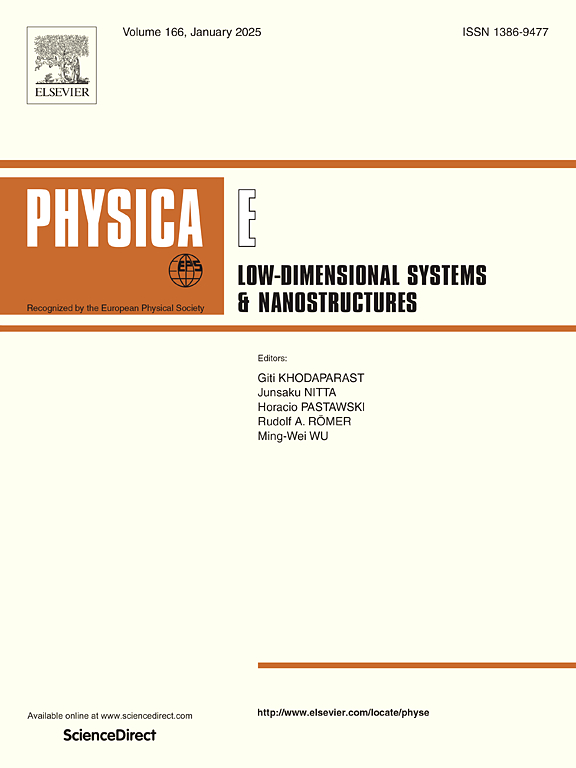褶皱CVD石墨烯中应变与掺杂的解耦策略及总有效应变评估
IF 2.9
3区 物理与天体物理
Q3 NANOSCIENCE & NANOTECHNOLOGY
Physica E-low-dimensional Systems & Nanostructures
Pub Date : 2025-06-12
DOI:10.1016/j.physe.2025.116311
引用次数: 0
摘要
化学气相沉积(CVD)石墨烯中应变水平的确定对于最大限度地发挥其电子和光电子应用至关重要。拉曼位移效应与掺杂效应的结合在试图精确提取与变形相关的精确测量时造成了困难。本研究使用开尔文探针力显微镜(KPFM)、拉曼光谱和高分辨率应变映射来解耦掺杂的应变。该研究方法通过正确区分掺杂的拉曼位移效应来提高应变检测精度,从而实现精确的机械应变测量。通过KPFM测量表面电位差,可以确定掺杂浓度。应用于g波段和2d波段拉曼位移的校准因子可以去除掺杂效应,因此可以访问实际的机械应变值。拉曼导出的平面应变测量范围为g波段的- 0.34%至- 0.53%,2d波段的- 0.35%至- 0.67%。基材引起的变形和起皱引起的面外变形产生压缩残余应变,这是通过曲率分析和AFM形貌测量证实的。偏振拉曼光谱分析表明,拉伸和压缩的应变分量遵循材料中皱褶和变形的方向。这种先进的应变掺杂解耦方法创造了一种精确的测量方法来确定石墨烯的真实应变,这可能有助于加速应变石墨烯在电子和光电器件、柔性系统以及传感器中的应用。本文章由计算机程序翻译,如有差异,请以英文原文为准。
A new decoupling strategy for strain and doping in wrinkled CVD graphene with total effective strain evaluation
The determination of strain levels in chemical vapor deposition (CVD) graphene is essential to maximize its electronic and optoelectronic applications. The combination of Raman shift effects with doping effects creates difficulties when attempting to precisely extract accurate deformation-related measurements. This research decouples strain from doping using Kelvin Probe Force Microscopy (KPFM), Raman spectroscopy, and high-resolution strain mapping. The research methodology allows precise mechanical strain measurement by properly distinguishing Raman shift effects from doping to enhance strain detection precision. Surface potential difference measured by KPFM enables determination of doping concentration values. Calibration factors applied to G-band and 2D-band Raman shifts enable the removal of doping effects so actual mechanical strain values become accessible. The Raman-derived in-plane strain measurement ranges from −0.34 % to −0.53 % for the G-band and −0.35 % to −0.67 % for the 2D-band. Substrate-induced distortions and wrinkle-induced out-of-plane deformations create compressive residual strain which is confirmed through curvature analysis and AFM topography measurements. The analysis from polarized Raman spectroscopy demonstrates that strain components for tension and compression follow the orientations of the wrinkles and deformations in the material. This advanced strain-doping decoupling method creates an exact measurement method to determine true graphene strain which may help accelerate use of strained graphene in electronic and optoelectronic devices and flexible systems as well as sensors.
求助全文
通过发布文献求助,成功后即可免费获取论文全文。
去求助
来源期刊
CiteScore
7.30
自引率
6.10%
发文量
356
审稿时长
65 days
期刊介绍:
Physica E: Low-dimensional systems and nanostructures contains papers and invited review articles on the fundamental and applied aspects of physics in low-dimensional electron systems, in semiconductor heterostructures, oxide interfaces, quantum wells and superlattices, quantum wires and dots, novel quantum states of matter such as topological insulators, and Weyl semimetals.
Both theoretical and experimental contributions are invited. Topics suitable for publication in this journal include spin related phenomena, optical and transport properties, many-body effects, integer and fractional quantum Hall effects, quantum spin Hall effect, single electron effects and devices, Majorana fermions, and other novel phenomena.
Keywords:
• topological insulators/superconductors, majorana fermions, Wyel semimetals;
• quantum and neuromorphic computing/quantum information physics and devices based on low dimensional systems;
• layered superconductivity, low dimensional systems with superconducting proximity effect;
• 2D materials such as transition metal dichalcogenides;
• oxide heterostructures including ZnO, SrTiO3 etc;
• carbon nanostructures (graphene, carbon nanotubes, diamond NV center, etc.)
• quantum wells and superlattices;
• quantum Hall effect, quantum spin Hall effect, quantum anomalous Hall effect;
• optical- and phonons-related phenomena;
• magnetic-semiconductor structures;
• charge/spin-, magnon-, skyrmion-, Cooper pair- and majorana fermion- transport and tunneling;
• ultra-fast nonlinear optical phenomena;
• novel devices and applications (such as high performance sensor, solar cell, etc);
• novel growth and fabrication techniques for nanostructures

 求助内容:
求助内容: 应助结果提醒方式:
应助结果提醒方式:


